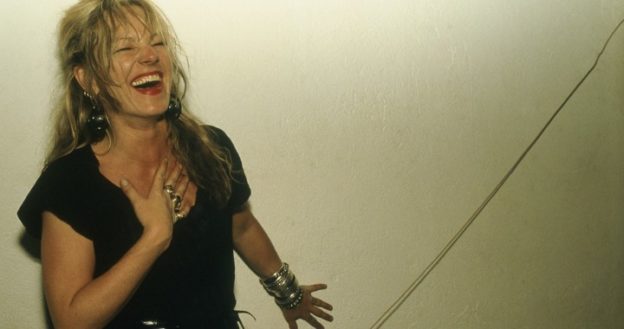“Two generations before, let’s say the Beats—Ginsberg, Burroughs, Corso—they were still around and it was such a hard thing for writers to follow….It wasn’t until the generation of Cookie Mueller, David Trinidad, Tim Dlugos, and Dennis Cooper who really got on to something new….They broke away. They were relating to Frank O’Hara…[a] very urban contemporary, Apollinaire sort of thing tied in with the painters.” — Raymond Foye*
It’s easy to say that EDGEWISE: A PICTURE OF COOKIE MUELLER, by Chloé Griffin, is a twenty-first century Edie. They’re both oral histories of a New York underground, and there are some surface similarities between Edie Sedgwick and Mueller. Supernovas, especially when they’re women, tend to get lumped together. But Mueller was a better actress than Sedgwick, and—in everything from dieting to drug-taking—more disciplined.
And she could write. (Gary Indiana was her strongest early advocate.) High Times, the East Village Eye, Cuz, and Details published her art reviews and advice columns. Mueller’s first book—How to Get Rid of Pimples—was published by Anne Turyn‘s Top Stories, and Mueller co-wrote the play Drugs with the late Glenn O’Brien.
We’re lucky to have Mueller’s words and the memories of her friends in Chloé Griffin’s EDGEWISE. If traces of Warhol’s Sixties still blow through Manhattan, Mueller’s late Seventies avant-garde has dissolved into finer dust.
For those too young to know or remember, EDGEWISE is a voyeur’s dream, and an introduction to a world to be discovered—the stories and plays and photographs and music and films of David Armstrong, Bette Gordon, Sara Driver, Michael Oblowitz, Penny Arcade, Richard Hell, Eric Mitchell, Rachid Kerdouche, Lynne Tillman, Peter Hujar, Michel Auder, Amos Poe, and Cookie Mueller.
“Nobody could possibly be as solidly grounded in Bohemian glamour as she was. Just one of a kind, it was all her own. She was too cool to be competitive.” — Kate Simon*

Chloé Griffin, EDGEWISE: A PICTURE OF COOKIE MUELLER (Berlin: b_books Verlag, 2014).
WALKING THROUGH CLEAR WATER IN A POOL PAINTED BLACK, by Cookie Mueller, kicked off Semiotext(e)’s Native Agents series in 1990.
*Foye and Simon quotes from EDGEWISE. In 1984, Foye and Francesco Clemente founded Hanuman Books, and published Mueller, Trinidad, Allen Ginsberg, Eileen Myles, Herbert Huncke, and John Ashbery.
See EDIE: AN AMERICAN BIOGRAPHY, by Jean Stein and George Plimpton (New York: Alfred A. Knopf, 1982). A year after publishing West of Eden (2016), her oral biography on five prominent Los Angeles families (including her own), Stein jumped to her death from her 10 Gracie Square apartment in New York City.

From top: Cookie Mueller, photograph by Nan Goldin, 1985; book cover image courtesy of b_books Verlag.; Mueller and singer Sharon Niesp dancing in the Back Room, Provincetown, 1976, photograph by Goldin. Mueller photographs courtesy of Nan Goldin and Matthew Marks Gallery.






